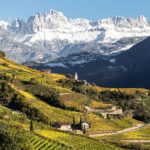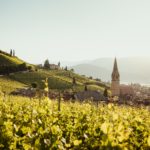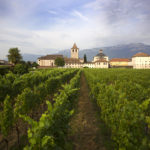ALTO ADIGE – STUNNING ALPINE SCENERY AND EXQUISITE WINES

Alto Adige – beautiful and diverse
Alto Adige, Italy’s most northern region and one of its smallest, is an extraordinarily beautiful and fascinating region with stunning mountain scenery, green valleys and a rich patchwork of vines where some of Italy’s most exquisite wines are made. While the magnificent mountains of the Dolomites, a UNESCO World Heritage Site, form a permanent backdrop, towering to an altitude over 3000m, vines grow up to 1000m.asl in picturesque valleys and on sun-kissed slopes. The climate provides excellent conditions with considerable temperature swings, around 300 days of sunshine per year and an immense variety of terrains including limestone, porphyry and marl.
Alto Adige – a destination for all seasons
Alto Adige shares borders with Austria and Switzerland and three official languages are spoken (Italian, German and Ladin) which all contributes to a refreshing mix of cultures, cuisine, traditions and styles. The region is a true year-round destination with something to offer in every season and for every preference. Winter is ideal for lovers of snowsports, with endless slopes suitable for all levels of expertise, from beginners to pros becoming a playground for snowboarders, downhill and cross-country skiers as well as for ski mountaineering, ski touring and the increasingly popular snowshoeing. But winter is also the time for Christmas markets and roaring fires in atmospheric mountain huts and cosy wine bars serving delicious specialities and local wines. Each year, the region’s wine consortium organises wine-themed initiatives and tastings on the slopes and what better way to really get under the skin of Alto Adige. When the snow melts and nature comes to life with fresh green springtime vegetation and the all-important bud break occurs in the vineyards, the mountains become the domain of hikers and bikers. The trails are particularly popular through the summer months when the season’s grapes drink up the sunshine and work their way to full maturity. Come autumn, the leaves take on their rich golden, yellow and red hues and vineyards and wineries become a hive of activity, with the excitement of the new harvest and anticipation of what this year’s vintage will offer creating a buzz in the air. This is also the time of Törggelen, the annual tradition when farms and wineries usually closed to the public, open their doors to visitors for convivial occasions with grape juice and chestnuts as well as genuine home-made food and, of course, wine.

Alto Adige – the wines
Evidence has been found that wine has been made in Alto Adige for over 2,500 years. Nowadays white varieties dominate the scene to a rate of 65% with 35% red. International grapes Pinot Grigio and Chardonnay lead the way among the whites, making complex and structured wines. Gewürztraminer, the intensely aromatic traditional grape is also widely produced although refreshing Pinot Bianco is more frequently consumed among the locals. Some superbly expressive Riesling and Sauvignon Blanc is also made here and Moscato Giallo, typically made as a sweet passito wine, is increasingly being produced in intriguing dry versions. When it comes to reds, the region’s native Lagrein and Schiava dominate the scene, Lagrein giving smooth, velvety reds with a deep purplish colour and chocolatey, dark fruit character. There’s also a traditional rosé version of Lagrein, called Kretzer, generally bright cherry pink with fresh fruity aromas that are best enjoyed young. Schiava reds are delicate in both colour and structure – they’re generally light wines with red berry aromas and are often served slightly chilled. Other reds include elegant and intense Pinot Nero, a variety also grown here for sparkling wines, along with Pinot Bianco and Chardonnay. While the vast majority of the region’s wines are still, there is in fact a growing interest among winemakers for Alto Adige spumante. Many producers are nowadays investing in fungus-resistant varieties too, such as Souvignier Gris and Solaris, in a move to reduce vineyard intervention in an ever-changing climate. Respect for the environment is deep-rooted in everyday life in Alto Adige and sustainability and biodiversity are priorities in the wine world. The regional wine consortium has its own 2030 Agenda for sustainable development and teamwork is a byword.
Alto Adige – the wineries
While the majority of Alto Adige’s 4800 wineries are small and family run, often with charmingly rustic structures or stylish contemporary alpine architecture, some historic estates are based at stunning abbeys and castles. Guests are welcome almost everywhere and producers are diversifying, often offering a variety of experiences, accommodation or meals and a visit to the wineries is an unforgettable way to gain a real insight into the local wine scene. The region’s cooperatives should also not be overlooked – in recent years the coops have been leading the way, making the most of their resources with pioneering research and new excellence.

Alto Adige – the wine areas
Alto Adige currently produces less than 1% of Italy’s wine and on average winegrowers have just one hectare under vine. It’s a diamond tip of production however and 98% of the region’s wines adhere to a DOC. The region’s wines are made in a roughly Y-shaped territory around the regional capital, Bolzano and there are two separate denominations – Alto Adige DOC and Lago di Caldaro DOC – with altogether seven wine areas or subzones.
Lago di Caldaro
While the DOC area is shared with the neighbouring Trentino region, the wines produced in Alto Adige can display the word ‘Classico’. Lake Caldaro is a gorgeous, scenic spot surrounded by vineyards with its own microclimate thanks to the lake’s influence. Wine-themed events and initiatives are frequent and there’s a good selection of wine bars and wineries that welcome visitors. The fresh waters are inviting for a swim on hot summer days and water sports facilities are available too. The principal variety in this area is Schiava for reds that are highly drinkable, fruity and fresh.
Alto Adige Valle Isarco
Enjoying a decidedly cooler climate than the other subzones, the 80km-long Isarco river valley to the north east of the region stretches from the attractive cathedral city of Bressanone in the north to Bolzano in the south. Thanks to its climate and extreme temperature swings, this is one of Italy’s prime areas for elegant and characterful white wines. The fresh and fragrant Sylvaner leads the way alongside some excellent versions of other varieties – Veltliner, Kerner, Pinot Grigio, Gewürztraminer, Riesling and Müller Thurgau are all made here too.
Alto Adige Santa Maddalena
The slopes just north of Bolzano are home to the small Santa Maddalena subzone and the vineyards can be reached by following the St. Oswald footpath from the city. It’s one of the sunniest spots of the region and has some of the oldest vines, often traditionally pergola-trained making for a scenic landscape. Santa Maddalena wines, Schiava-based reds with a slender and fragrant elegance, are highly contemporary and extremely versatile. Schiava is actually a family of varieties including Schiava Grossa, Schiava Gentile and Schiava Grigia, all three of which are permitted for Santa Maddalena wines and a classic pairing is a glass or two with a platter of Speck.
Alto Adige Terlano
Besides wine, this part of the Adige river valley west of Bolzano is celebrated for its many apple orchards and even more so for its fragrant asparagus. April is the perfect time to visit when the apple trees blossom and fresh asparagus is abundant – asparagus tours and events are also organised. The Terlano subzone allows for exclusively white wines – the local Sauvignon Blanc is a classic pairing for asparagus-based dishes. When no grape variety is mentioned on the label, the wine must be made of at least 50% Pinot Bianco and/or Chardonnay.
Alto Adige Meranese
This area is around the historic town of Merano, known for its elegant architecture and for its spa with indoor and outdoor pools of natural thermal waters. It’s also the location for the prestigious international Merano Wine Festival held each November and home to several top restaurants. While Meranese subzone wines are spicy and fresh Schiava-based reds, with up to 15% of other varieties permitted, the area also produces rich, fruit-filled Lagrein and some fine Pinot Nero in addition to the region’s principal white varieties.
Alto Adige Val Venosta
This subzone in the north western part of Alto Adige’s wine-producing area enjoys dramatic day-to-night temperature swings which contributes to the intense aromas of the wines. A number of grape varieties are permitted for Val Venosta subzone wines and the variety must always be mentioned on the label. Riesling is a particular local star, together with Pinot Bianco – the region’s go-to white – and Kerner, Chardonnay, Pinot Grigio, Müller Thurgau and Gewürztraminer for the whites plus Schiava and Pinot Nero reds. Val Venosta is an ideal spot for lovers of outdoor sports.
Alto Adige Colli di Bolzano
This area of hills surrounding the region’s capital, Bolzano forms a kind of embrace around the adjacent Santa Maddalena subzone and here too the subzone wines are fragrant reds made with Schiava grapes. Bolzano itself is a fascinating place, where Germanic and Mediterranean traditions blend in the architecture, lifestyle and especially in the many and varied restaurants. The deeply-rooted wine culture is very much in evidence, vines grow within the city and even the cathedral has a historic ‘wine door’ where wine was once sold.

ALTO ADIGE – THE MUST-TRY FLAVOURS
Speck – Platters of speck, the lightly smoked (typically with beechwood) local speciality prosciutto, are abundant at wine bars, mountain huts and restaurants, both low-key and exclusive. Speck is also a frequent ingredient of other dishes from pizza to pasta, salads to omelettes and traditionally finds its partner in a glass of Schiava. Canederli – One of the region’s best loved dishes, these large dumplings are often flavoured with pieces of speck, cheese, herbs or vegetables and the classic way to serve them is with melted butter and chives. Ideal with local Lagrein or Pinot Nero. Spätzle – These small green gnocchi made with spinach are a favourite on Alto Adige menus. They’re often served with a temptingly creamy speck-based sauce and are ideally paired with a refreshing Alto Adige Pinot Bianco. Apple strudel – No meal is complete in Alto Adige without a slice of strudel made with deliciously fragrant local apples, also ideal as a breakfast treat or anytime snack. Try it with an intense, aromatic Gewürztraminer passito.
ALTO ADIGE – QUICK FACTS
5800ha under vine (1% of Italy’s total)
4800 winegrowers
40 million bottles produced each year
including 450,000 Traditional Method spumante
65% white wines, 35% red wines
20 varieties of grape
Altitudes of vines 200-1000m.asl
98% of wines are DOC